
foreword | Historical Narratives | Resources | Links | Contact
THE 1ST PARLIAMENT OF UPPER CANADA
History is the life of peoples and humanity.
Monday, September 17th 1792, was a big day in the backwoods of Upper Canada. At Newark [Niagara-on-the-Lake], the colony's 1st Parliament opened under primitive but very proud circumstances.
For years a vexing question has surrounded the opening of our first legislature: where was it held? Some sources say the first session of Parliament was held in "a marquee tent" pitched on the commons above Fort George. The spot was marked by an old oak tree known as the "Parliament Oak." A picture of the decaying tree is in the Niagara-on-the-Lake museum. Butler's Barracks, Navy Hall, Government House and Fort Niagara have also been suggested as the location of that historic session. Still another reference locates that first session "under a tree with a large stone serving for the Clerk's Table." Another asserts that the First Session was held in Freemason's Hall, which had "an upper and a lower chamber, the former the Masonic Hall and the latter used for public gatherings." On the occasion of the opening, "Soldiers lined the route from Navy Hall to the Masonic Lodge building, the latter known as Freemason's Hall was constructed earlier by some enterprising masons."
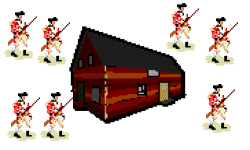 |
|
Navy Hall |
In its description of the event, the words "Government House, Navy Hall" are used repeatedly. We also have it on good authority from Simcoe's secretary, Major Edward Baker Littlehales, that the first meeting of the Legislature took place in Navy Hall, the name given to four buildings used by the navy - partly for residence, for shelter and partly for storage of sails, cordage, etc. The records of the Upper Canada Gazette appear to settle with some certainty the actual location of the opening of the first Parliament. Subsequent sittings of parliament were held in another location.
 |
On the hill above Navy Hall there were several wooden barracks that had housed Butler's Rangers during the American Revolutionary War 1775-83. One of these buildings was converted for use as the council chamber for later sessions of the Legislature. Simcoe referred to this when he wrote that
In His Own Words "additions made to Butler's barracks by men of the garrison were for the meeting of the Legislature of the Country and public offices."Navy Hall was a two-storied, gambrel-roofed barracks originally constructed in 1765. It was a plain frame building used for the accommodation of commanders of the British sloops-of-war on Lake Ontario and for housing stores to supply the vessels on the western part of the lake. Originally it was not so much one building, as a cluster of buildings, one a long structure located at right-angles to the river and three others beside it which were parallel to the river. Situated on the west bank of the Niagara River the buildings as well as a wharf were just below where Fort George now stands. Once it was rehabilitated Navy Hall served as Simcoe's official residence where he entertained various distinguished guests including Prince Edward, Duke of Kent, father of Queen Victoria and Alexander Mackenzie, the great explorer. Another guest was the Duc de la Rochefoucauld-Liancourt, a French nobleman who visited in 1795. Rochefoucauld described Simcoe's home as being "a small, miserable wooden house formerly occupied by the commissaries." Simcoe said he never expected a palace and he was not disappointed.
Renovations on Navy Hall were still underway when word was received that a very important guest, King George III's son, Prince Edward, was about to arrive with a large entourage. His unexpected and poorly-timed appearance forced the Simcoes to vacate the comfortable tent in which they were living.
 |
They were forced as Mrs. Simoce recorded, to move into
In Her Own Words, "the miserable, unfinished, damp room, smelling atrociously of fresh paint and wet plaster."Several days later as Elizabeth sat alone in this dismal setting gazing at the gale howling outside the window she confessed she was "most dispirited."
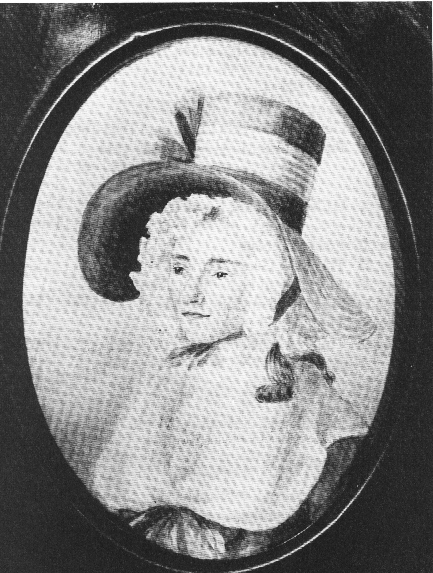 |
|
Elizabeth Posthuma Simcoe |
Earlier in Kingston on the 8th of July, 1792 Simcoe, dressed in the regiment's scarlet and gold rather than green and silver of the Queen's Rangers, arrived at St. George's Church for the swearing-in ceremonies. He was attended by three members of the Executive Council: the Hon. William Osgoode, Chief Justice, the Hon. James Baby and the Hon. Peter Russell. Osgoode administered the oaths of office and each solemnly swore to faithfully administer the colony's new constitution which was described by Simcoe as "the most excellent that was ever bestowed upon a colony."
While Simcoe described it as "the image and transcript" of Great Britain's, this was not true. Correctly speaking there was no such thing as the British Constitution in existence. There is and has been for ages plenty of governing power, but as to a Constitution or supreme law, there is no such thing. The British government is made up of old usages, old charters, old fictions and old prejudices. Examine it in its whole or in its parts, the sign may be found, but the substance will be missing.
The "image and transcript" of the British Constitution which Simcoe lauded so highly was hardly deserving of the praise. One of its most controversial features specified in bold relief that one seventh of the province or 15,000,000 acres were to be appropriated forever to an established clergy - the Anglican church. Without ceremony and without a by your leave to the people, the Church of England took possession of the whole from the very first and snapped its pious fingers in defiance at all the other Christian churches throughout the province to their frustration and ultimately bitter resentment.
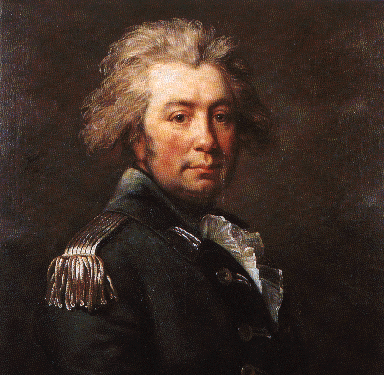 |
|
John Graves Simcoe |
Simcoe informed the councillors that he would select a convenient spot for the first meeting of the Legislature and after due consideration he chose Niagara, which he promptly renamed Newark, for Simcoe always preferred English to Natives names. Much to the anger of Joseph Brant, Simcoe made changes whenever he could. He selected Newark as the new capital and his military and civil headquarters, because it was easily accessible by water to the various settlements scattered about the province. It was also the location of many Loyalists from the Queen's and Butler's Rangers, who following the fighting that ended by the treaty of 1783, had paddled across the Niagara River to their new homeland. The site was also well protected by the guns of Fort Niagara across the river, which despite the terms of the peace treaty that ended the American Revolution, was still occupied by a British garrison and if Simcoe had his way, it would continue to be so occupied.
 |
The wording of the time is reflected in this proclaimation by Lieutenant Governor John Graves Simcoe, summoning Parliament to assemble in 1794 here on the edge of the empire.
"George III by the grace of God, of Great Britain. To our beloved and faithful counsellors of our Province of Upper Canada, our faithful knights, citizens and burgesses of our said Province for the Assembly at our town of Newark ----- Greeting Commanding and by the tenor of these presents firmly enjoining you and every one of you and all others in this behalf interested that on the 22nd day of September next at our said town of Newark personally you and every one of you be and appear to treat, do, act and conclude upon those things which in our said Assembly, by the Common Council of our said Province, by the favour of God, may be ordained. In testimony whereof these our letters we have caused to be made patent and the great seal of our said Province to be hereunder affixed.
Witness our Trusty and Well Beloved John Graves Simcoe, Esquire, LG and Colonel Commanding our Forces in the said Province at our Government House, Navy Hall, this 10th day of August, 1794, in the thirty-fourth year of our reign."
Simcoe arranged the opening of the first parliament in the tiny clearing on the sloping banks of the Niagara River with all the pageantry and pomp he could manage. To the martial rhythms of fife and drum Simcoe, clad in scarlet tunic with gold braid and buttons, rode in stately procession to Navy Hall - his Westminster in the wilderness. Escorted on either side by his aides-de-camp, Lieutenants Thomas Talbot and Thomas Grey of the 24th and 26th Regiments respectively, Simcoe was accompanied by a mounted honour guard of the 5th Regiment. Behind the Governor rode retired military officers in brilliant regimental dress followed by settlers in plain homespun and Native warriors in paint and feathered finery. Nest came mounted guards dressed in scarlet coats with white straps and belts, their burnished buttons shimmering in autumn sunlight. Bringing up the rear in their dark green uniforms were the Queen's Rangers. The whole scene was framed in the glorious colours of the Canadian autumn.
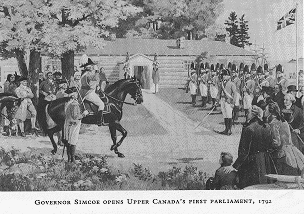 |
|
Primitive Pomp and Pageantry |
The great guns at Fort Niagara guarding the gateway to the west thundered their salute while cannons countered on ships at anchor in the harbour, the thunderclap of each salvo echoing through the sylvan silence.
The collective wisdom of the tiny colony had assembled in the humble wooden hall to hear Simcoe resplendent in his ceremonial uniform read his speech from the camp stool that served as his makeshift throne. Nearby the sergeant-at-arms stood stiffly at attention. Among the awed onlookers packing the airless room were travellers, traders and farmers from remote parts of the province as well as imposing buckskin-clad braves of the Six Nation's Tribes.
Proceedings were opened with a prayer by the Chaplain, the Reverend Dr. Robert Addison, who had come to Niagara in 1791 as a missionary of the Society for the Propagation of the Gospel in Foreign Parts. In suitably measured, solemn tones Simcoe began his first speech from the throne.
"Honourable gentlemen of the Legislative Council, gentlemen of the House of Assembly, I have summoned you together under an Act of Parliament which has established the British Constitution and all the forms which secure and maintain it in this distant country."
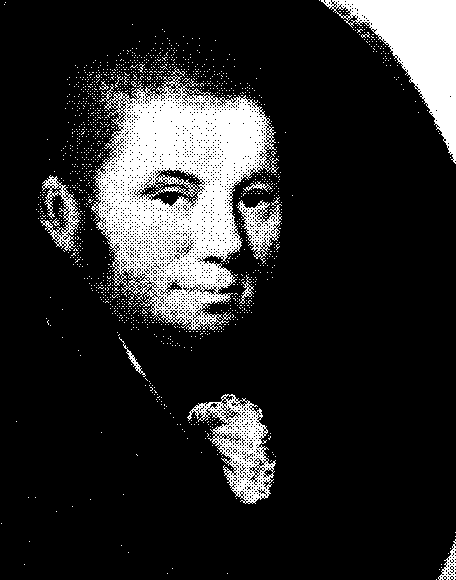 |
|
John Graves Simcoe |
Simcoe praised the wisdom and beneficence of their Gracious Sovereign and the British parliament for providing such a constitution. He urged Members to act with due deliberation and foresight as they grappled with their duties "so that the natural advantages of the Province of Upper Canada which are inferior to none on this side of the Atlantic" would provide a foundation of industry, wealth, commerce and power that "may last through all succeeding ages." He told the legislative listeners that as representatives of the British nation, "great and momentous trusts" had been committed to them. The men and the women in the room were about to fulfill their duties and their destinies.
The meeting of the colonial legislature exemplified the linkage that connected the corridors of power in Parliament and the backwoods of Upper Canada. While the loyalty of members of the House of Assembly to the mother country was strong, it was tempered by the lasting influence the land to the south still had on them. The members were Anglo-Americans and their hopes and concepts for the colony were shaped by this dual legacy, an outlook neither shared nor understood by Simcoe and his immediate successors. The migrant members were from another world and their view of the colony and its needs was quite different from that of the colonial leaders.
Only seven Assemblymen were present for the opening of parliament. At the time the summons was sent to the newly-elected legislators, Simcoe had overlooked the fact that harvest-time duties might well prevent some members from attending the legislature. Seven more members eventually participated for part of the month-long session. Two never made the first session at all.They undoubtedly decided that a more pressing concern was harvesting and storing crops to see them and their families safely through the long, cold winter. As the Duc de Rochfoucauld remarked when he witnessed the sparse attendance at the opening of the session in 1795,
In His Own Words
"The harvest engages the public attention far beyond what state affairs do."
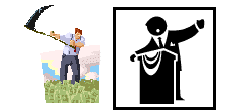 |
|
Bringing In The Sheaves |
Initially Simcoe was disappointed with the electors' choices. As he had anticipated they had chosen men who "kept but one table," that is, common folk who ate with their servants. He feared these individuals would be infected with that curse of kings and their courts - a democratic spirit.
The Legislature numbered twenty-three men in all, sixteen elected members of the Legislative Assembly and seven appointed members to the Legislative Council. The Council, whose members were hand-picked by the governor, was to dominate life in the little colony for some fifty years by exercising an undue influence on Simcoe's successors.
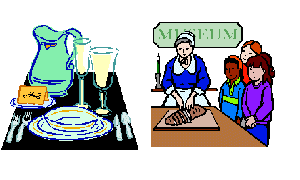 |
|
Nobility Kept Two Tables |
The governor was the colonial equivalent of the king and he acknowledged no responsibility to the people nor to their elected representatives. He answered only to the British government which appointed and paid him. The governor's officials in turn acknowledged responsibility solely to Simcoe. The members of the Executive Council, which served as a kind of cabinet, were also chosen by Simcoe. Since Simcoe's Executive Councillors were members as well of the Legislative Council power was effectively concentrated in the hands of a very few individuals.
Only one member of the Executive Council, John White, was also a member of the House of Assembly. White, the Attorney-General, represented the riding of Leeds and Frontenac. Simcoe had proudly informed the Secretary for the Colonies in London that he had orchestrated White's election.
In Simcoe's Own Words
"It was by good fortune that the temporary residence I made at Kingston created sufficient influence to enable us to bring Attorney General White into the House."
Most members of the Assembly were a rougher lot "fellows of one table," humble folk who in most cases came some distance under difficult conditions to sit and serve. They travelled by horseback and on foot from isolated clearings in the dense, trackless forests or by boat on rivers and the lake whose shores reflected on its shimmering surface the inverted images of the towering timbers that covered the land. As far as Simcoe was concerned, the elected chamber was expected to be largely a debating society whose members after brief and dutiful discussion would approve the government's initiatives. In the beginning Members of the Assembly complied for as tyros they were generally content to perform elementary duties that called for paltry political skills and created minimal friction.
 |
|
Men with a mission. |
Upper Canada's first parliament was convened during perilous times. An ill-defined and undefended border separated British Canada and the United States and tensions between the two were always present. Many anticipated an armed American invasion at any time. It was fully expected the Americans would be aided by their French allies who during the month of September, 1792 were busy abolishing the monarchy and decapitating their king. American colonists were passionately preoccupied with possessing ever more of the fertile land that lay between the two lakes and Upper Canada. The province projected like a giant finger into the centre of the continent blocking their access to the western frontier, forcing them to travel south through the Ohio country, home of the fierce and undefeated Shawnees and Miamis. American lust for land was countered by the Aboriginals' determination to defend to the death their threatened existence. The anticipated clash between these two cultures created fear and dread among the 12,000 Canadians sprinkled across the forested frontier, the silent solitude broken only by the cry of a crow, the howl of a wolf or the growl of a bear. The colony's fears were all the greater because it could not count on the protection of the powerful British fleet. If a second war should occur many felt it would provide the Americans with the opportunity to do what they had earlier failed to accomplish, that is, rid the continent forever of the British presence.
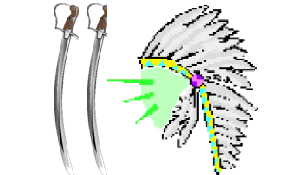 |
|
Coming Conflict |
Copyright © 2013 Website Administrator